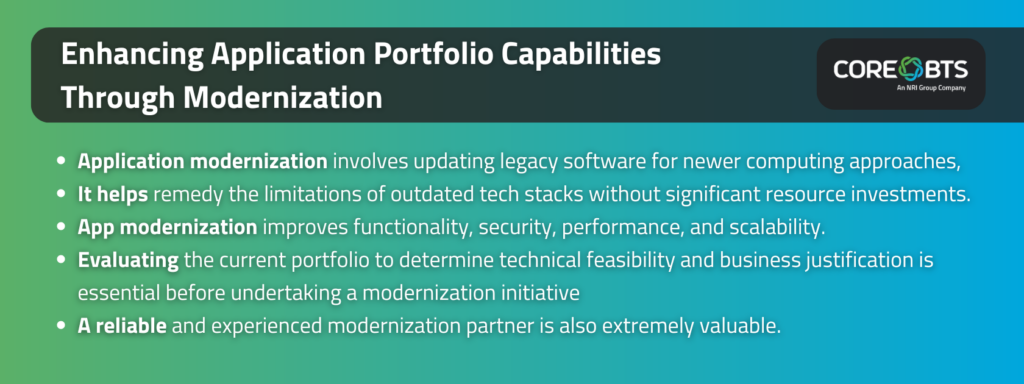With technology and market demands changing rapidly, businesses must evolve their capabilities and find innovative ways to stay competitive. Forward-thinking businesses are increasingly turning to modernization to bridge the gap.

Application modernization is crucial to maintaining business performance and agility in a constantly evolving landscape. It empowers internal teams with all the capabilities of the latest digital technology, driving security, reliability, and performance. At the same time, it lets you deliver better solutions and services to customers while paving the way for your business to scale.
Let’s look more closely at what application portfolio modernization entails and how businesses can get started with their digital transformation strategy.
Application Modernization Explained
Businesses often have significant operational and financial investments tied to their current application portfolio. Understandably, few are willing to scrap these applications and create new ones when they age or become legacy, even when they’re mission-critical; potential productivity losses and costs are too great. At the same time, using them with existing limitations isn’t ideal. Here, modernization makes sense.
Application modernization involves updating legacy software for newer computing approaches, including contemporary infrastructure platforms, languages, architectures, and frameworks. It’s the equivalent of renovating an old house to take advantage of improvements to structural integrity, safety, or efficiency.
Rather than retiring existing applications and building new ones from scratch, modernization extends their lifespan while taking advantage of the latest technology stack. It also lets you maintain business continuity and retain many existing processes.
Cloud migration is often top of mind when decision-makers consider application modernization. And rightly so; modernization heavily entails moving apps and workloads to the cloud. However, viewing modernization as simply a switch to the cloud misses the big picture.
For example, lifting and shifting legacy applications from on-premise to cloud environments doesn’t always lead to better security and performance. Sometimes, optimization (either to the application’s architecture, infrastructure, or features) is needed before the switch.
When to Consider App Modernization
Modernizing your application portfolio to stay ahead of the digital curve is a great idea in the following instances:
- Integrate advanced features that streamline workflows and elevate user experience
- Reduce dependency on humans for routine tasks
- Mitigate the risk of a data breach
- Minimize maintenance of legacy technology
- Improve compatibility with the most current technology
- Build on existing investments rather than developing new applications
Application Modernization Best Practices
Navigating app modernization can be complex. Luckily, having a solid strategy that considers key technical and business factors can help you prioritize efforts. These steps will set you on the right path:
1. Evaluate the current app portfolio
Take inventory of existing apps and identify what each application does, who uses it, where it is deployed, and how the portfolio is connected. This will allow you to develop a clean baseline to apply a first-pass filter of modernization candidates.
2. Determine what’s technically feasible to modernize
Analyze the data in source control systems to determine what’s technically feasible to move. The best way to do this is with an automated source code analysis tool that quickly detects cloud anti-patterns, technical debt, and legacy frameworks and rules out poor modernization candidates.
3. Determine the “why”
Be clear about what’s prompting the modernization. Is it functionality, security, scalability, efficiency, compliance, user experience enhancement, technical debt reduction, or something else? Ensure the desired business outcomes align with the planned end state to avoid a tech-focused project with limited business value, missed opportunities, and misguided efforts.
4. Prioritize what to modernize first
From your business and technical findings in previous steps, create a combined score to rank applications based on the level of modernization effort required and the business justification. This prioritized ranking will allow you to begin strategic discussions about the way forward.
5. Engage key stakeholders
While focusing on the technical details is crucial, don’t neglect the people aspect. Engage key stakeholders early and explain the benefits of the modernization initiative. With the groundwork laid out in the preceding steps, it’ll be easy to have fruitful and well-informed discussions about which apps make the best business justification for modernization.
It’s worth noting that the path to modernization isn’t straightforward. While getting the basics right will enhance your chances of success, challenges may arise before reaching the final destination. Having an experienced partner to help you navigate can make all the difference. That’s where Core BTS comes in.
Core BTS Can Support Your Modernization Efforts
Core BTS offers custom end-to-end enterprise-level cloud app modernization solutions to propel businesses forward. We meet businesses wherever they are on their journeys and help them maximize the benefits of modernization.
Recently, a forward-thinking healthcare business wanted to leverage digital technology to meet increasing demand for its services. Knowing that Core BTS would be the right partner, the business tapped us to enhance the security and functionality of its app portfolio.
We helped the business rebuild eight applications on Microsoft Azure and transform three legacy-on-prem databases using Azure Data Factory and Databricks. The business is now leveraging its new capabilities to improve the lives and experiences of its partners, associates, and customers. You, too, can unlock similar possibilities with Core BTS.
Read the full case study to discover the Core BTS advantage when modernizing and migrating applications to the cloud.



